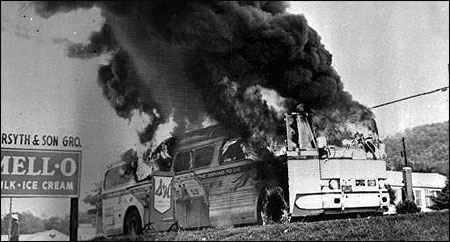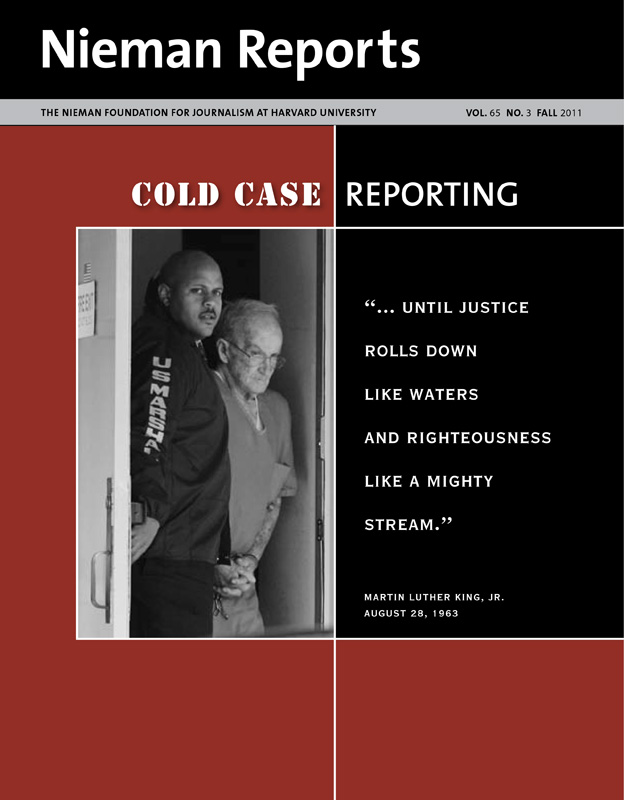
A Freedom Rider bus was firebombed near Anniston, Alabama in 1961. Photo by The Associated Press.
Some of the 13,000 blacks at the Mississippi voting rights rally on April 29, 1955 probably knew the Rev. George W. Lee was taking a risk when he compared the Delta to hell, telling them to pray they would make it through alive. Lee was from Belzoni, where whites had a particularly bad reputation for dealing with blacks who didn’t “know their place.” But he was not the only speaker whose rhetoric fired up the largest voting rights rally ever held in the South—and the first since the Supreme Court, one year earlier, had declared segregated schools unconstitutional. Detroit Congressman Charles Diggs was there, too, under the huge tent in the black township of Mound Bayou, warning that time was “running out” for Jim Crow in Mississippi.
Even though tensions were rising in the South following the Brown v. Board of Education decision and the first of the white Citizens’ Councils to organize against it had just sprung up in neighboring Sunflower County, Mississippi, no mainstream press covered the rally. Nor did they cover Lee’s gangland-style murder one week later, although it, too, was a first—the first civil rights murder since Brown.
Nothing in my background prepared me for the raw hatred and state-condoned terrorism I encountered on my first forays into the Mississippi Delta on assignment for Jet magazine in the mid-1950’s. I learned quickly that for a black reporter to cover a civil rights story in the Deep South and live to tell about it, I had to blend in. I wore old clothes, carried a preacher’s Bible on the front seat of my car, and spent nights in the homes of clergymen and undertakers.
Two years earlier, I had given up what would seem to most young reporters, even today, to be the chance of a lifetime—a full-time reporting position on a major metropolitan daily. The first black reporter at The Washington Post, I had a broad range of assignments, many of them front-page stories. But none of the suggestions I submitted for in-depth treatment of news affecting the Negro community went anywhere. Managing editor John Russell Wiggins later told me that he had been deeply distressed by the flap the first time the newspaper ran the engagement notice of a Negro couple on the society page and more so by the stir over publication of a panel of photos of Korean War casualties, some black and some white. Readers weren’t ready for it.
Most of the newsroom staff wasn’t ready for integration either. Concerned about my icy reception, publisher Phil Graham encouraged me to come to his office if I were ever tempted to hit somebody. (I never did either.) The Post was a complete turnaround from the cordial collegiality I had experienced at Harvard in the Nieman Class of 1951, the second black accepted in the program. (The first was Fletcher Martin with The Louisville Defender in Kentucky.) Nieman Curator Louis Lyons was more than welcoming, as were the faculty and the other fellows. When I left Cambridge I was determined to use the experience in unique ways for the betterment of my people.
After two years at The Washington Post, I realized that was not what I was doing. In Chicago, Ebony publisher John H. Johnson recently had launched a pocket-sized weekly magazine and was recruiting the best staff he could find to make it the bible for news of concern to black America. That’s where I wanted to be.
Murder of Rev. Lee
A week after I returned to Chicago from the Mound Bayou rally and my interviews with Lee and other voting rights activists in the Delta, I got a call telling me of his murder.
At 51, he had been a cofounder of the local branch of the NAACP and was the first black since Reconstruction to register to vote in Humphreys County, Mississippi. He had gotten most of the county’s other blacks to register, but Sheriff Ike Shelton and the Citizens’ Council were using intimidation and economic pressure to purge each one of these voters from the rolls. Lee had been so successful that whites even offered him protection if he would cease his voter registration efforts. He refused, and on the evening of May 7, 1955, a bullet fired from a pursuing car into a rear tire of his Buick sent it careening off the road into a shanty as a Ford convertible pulled alongside and two shotgun blasts almost blew his face off.
Shelton took one look at Lee’s lifeless body and declared that the death was due to a concussion from a traffic accident. When a postmortem found lead pellets in Lee’s face and head, Shelton claimed they were dental fillings torn loose by the impact of the crash. When further investigation identified the pellets as buckshot, Shelton theorized that the reverend was a lady’s man who was gunned down by a rival.
A Federal Bureau of Investigation probe focused on two members of the small town’s Citizens’ Council who were known for prior acts of violence. The NAACP, after demanding the investigation, helped the bureau track down eyewitnesses to the murder. But when the FBI turned over its evidence to the local prosecutor, he declined to convene a grand jury. The agents held one suspect’s 20-gauge double-barrel shotgun and shells for use in a federal civil rights trial, but that never happened either. The United States Department of Justice said it could not substantiate allegations that the minister was murdered because of his voting rights activities.
Not a word about Lee’s case appeared in the nation’s major newspapers.
RELATED ARTICLE
“To Be a ‘Negro’ Newsman—Reporting on the Emmett Till Murder Trial”
– Simeon Booker Four months later, Jet broke with a journalism tradition by publishing a graphic photograph of another Delta murder victim’s mutilated face. The grieving mother had insisted that the world see what the kidnappers of 14-year-old Emmett Till had done to her boy. The issue sold out across the country, and the magazine ran an unprecedented second printing. For the first time in history, the white press descended in droves—about 100 in all—on a Southern courtroom for the trial of whites charged with murdering a Negro.
In one of several bizarre twists in the proceedings, the trial recessed after jury selection while three white reporters, including another former Nieman Fellow, Clark Porteous of the Memphis Press-Scimitar, joined me and other black reporters on a high-speed, midnight manhunt through the backwoods of the Delta, led by local civil rights workers and law enforcement officials hell-bent on finding terrified blacks rumored to have witnessed aspects of the crime. In the end, despite these eyewitness accounts and one defendant’s confession to the kidnapping, the all-white jury let the killers walk free.
On that day it was business as usual in that stifling Mississippi courtroom, but it was also the beginning of a new era in press coverage of civil rights cases.
Simeon Booker, a 1951 Nieman Fellow, retired in January 2007 as the Washington bureau chief of Jet magazine, where he had worked since 1954. In 1982 he received the National Press Club’s Fourth Estate Award. He recently wrote in Jet about his 1961 coverage of the Freedom Rides, describing the telephone call he made to Attorney General Robert F. Kennedy that resulted in federal protection for the riders. He is writing a memoir of his coverage of the civil rights movement and the administrations of 10 U.S. Presidents.


